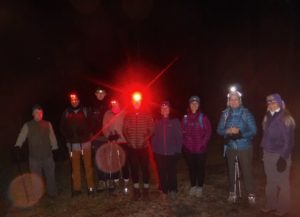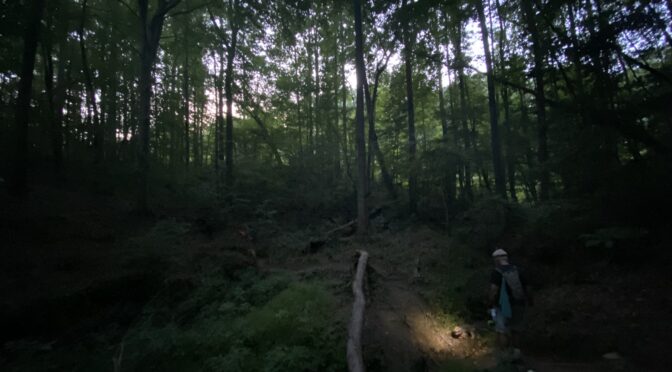The following is a version of a piece we run every year at this time, a time when our spirits are buoyed by day by cloudless skies and cooling temperatures, but bummed when those days of sun end earlier and earlier.
October is almost upon us, which for hikers is good in oh-so-many ways. With one possible exception.
While the cooler temperatures, sunny skies, and fall color all make for great hiking, there’s one drawback: shorter days. Consider: at the start of this month the sun didn’t set until 7:44 p.m. Come Saturday, the last day of the month, it will set at 7:01. By mid-October, the sun will call it a day at 6:41 p.m. Doesn’t leave much time for after-work time on the trail.
Or does it?
Notice I referred to October being ideal “With one possible exception.” Possible, because not everyone needs sunlight to hike. Including you.
When daylight begins disappearing earlier and earlier, we don’t let it keep us off the trail. We simply grab a torch like townsfolk of old and head into the night. Though in our case the torch is a headlamp, the objective, adventure.
Hiking at night offers some special rewards not found during the day. This type of hiking calls for different levels of concentration, as you focus on a world limited by an orb of light. As you scan for solid footing this problem-solving aspect of hiking improves both body and mind. You can tune in to the sounds of night life, which is not the same as the sounds of daytime critters (more owls than warblers, more raccoons than squirrels). And if you pause and look up, you can see the glories of the night sky (pausing is key; continue hiking while looking at the stars and it will ended badly). It’s a special place, the night world, and it is one well worth exploring.
We get that night hiking isn’t for everyone. If you’re hopelessly scared of the dark or have very poor night vision, for instance, you might want to pass. But for the rest of you open to the concept, we have some tips.
And if you like the idea of night hiking but not alone, you’re in luck (provided you live in the Triangle area). Our GetHiking! Fall 2023 Night Hike Series begins Oct. 11. More information on that weekly series and how to sign up is at the end.
Now, our tips:
- A headlamp. This is a must. Flashlights, work, sure, but you really want to keep your hands free. You can get a decent one for as little as $15; note that LEDs cast a more hike-friendly light. Be sure to pack both extra batteries and a spare light (a little pen light will do should you need to change out your headlamp batteries).
- Pick short hikes to start. Night hiking takes some getting used to. Your world is confined to the glow of your headlamp, and it takes some concentration to focus on such a limited portion of the trail. Surprisingly, it can be a sensory overload, as your other senses tune in to the world beyond the scope of your light. So don’t overstay on your first outing.
- Hike trails you’ve hiked in daylight. Even though it’s dark, familiarity is a huge plus. You’ll be amazed at how things you didn’t think you noticed during the day will pop out as key markers of where you are on the trail.
- Hike by your feet. It takes a bit more effort to scout out the blazes at night rather than in the day. The best way to tell whether you’ve wandered off the beaten path is if your boots are suddenly sinking into soft, untrodden leaf litter. Backtrack and seek out firm footing.
- Bundle up. Nighttime is cooler than day, of course. Counter the chill with one more layer than you think you’ll need; you can always shed a layer later.
- Don’t hike alone. I do a lot of soloing, but not at night.
- Again, take extra batteries. If your light goes out, you’re really in the dark.
- Again, take a backup light. Even a $5 keychain light can be a lifesaver if your main torch goes out. (Ever try to change batteries in the dark?)
- Take a map and compass.* You should already have these in your daypack, but make extra sure you have them at night.
- Take water and snacks. Just because it’s dark doesn’t mean you can’t get dehydrated. And hiking in the cool air while concentrating on the trail will burn some calories; you’ll be glad to have the extra fuel.
- Appreciate the night sky. Because that’s one big reason you’re hiking at night!
- Take a cell phone, just in case. Besides, most phones have a flashlight function that could save you in a pinch.
Note that most trails on public lands are closed from dusk until dawn. That includes some state parks and nearly all municipal and county trails. National forests typically don’t have hours, nor do lands managed by the N.C. Wildlife Resources Commission.
This fall and winter, embrace the night. Take a hike.
* * *
GetHiking! Fall 2023 Night Hike Series
 It’s not safe (and it can be a little scary) to hike by yourself at night. So join our GetHiking! Fall 2023 Night Hike Series, which begins Oct. 11 and runs through Nov. 14. We hike midweek, usually on Wednesday, starting at 6:30 p.m. and ending around 8 p.m. The hikes are leisurely paced, include stops to enjoy the night sky, and are all around 3 miles. Cost is $75, and includes 7 hikes in the Triangle area and our GetHiking! Guide to Hiking at Night. Plus, each week on the Monday preceding the hike you’ll get an eguide for that week’s hike that includes a map, trail description and more.
It’s not safe (and it can be a little scary) to hike by yourself at night. So join our GetHiking! Fall 2023 Night Hike Series, which begins Oct. 11 and runs through Nov. 14. We hike midweek, usually on Wednesday, starting at 6:30 p.m. and ending around 8 p.m. The hikes are leisurely paced, include stops to enjoy the night sky, and are all around 3 miles. Cost is $75, and includes 7 hikes in the Triangle area and our GetHiking! Guide to Hiking at Night. Plus, each week on the Monday preceding the hike you’ll get an eguide for that week’s hike that includes a map, trail description and more.
Learn more and sign up to join us here.
